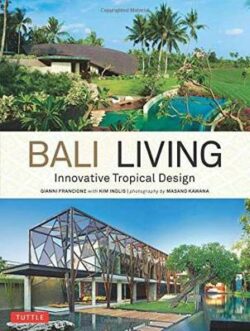Seen | Unseen
$89.99
Out of stock
Alert me when product is restocked
Description
The home designs of Alejandra Cicneros mark a significant departure from the tropical ‘Bali’ style villa design popularised in the past two decades. They are also a refreshing antidote to the often anodine concrete villas invading the centuries-old rice terraces of this visionary Argentinean architect’s adopted home. In Perfect/Imperfect Alej shares her insights on reimagining traditional homes for 21st-century lifestyles in today’s fragile environments. She reveals the thinking behind her designs, and her heart-centred process of co-creation – a ‘conspiracy of client, joglo, land, Balinese craftsmanship and culture’. She also acknowledges the influence of Tri Hita Karana, the Balinese concept of cosmological balance that governs their relationship with people, the environment and the Creator. AUTHOR: Alejandra Cicneros came to Bali on vacation in 2004, irrevocably fell in love with the Island of the Gods – and never left. With an Argentinian mother and Venezuelan father, Alej had an international upbringing from the start, living between Buenos Aires, Baja California, and New York, with family life infused with art, music and languages (she speaks English, Spanish and Bahasa Indonesian fluently). One of her childhood homes – a house designed by a disciple of Frank Lloyd Wright – kindled her interest in architecture as well as a life-long passion for barrier-free indoor/outdoor living. SELLING POINTS: . Captures the contextual background of the design-led influence of Tri Hita Karana, the philosophy of balance in Balinese living . Includes design projects for a wide range of international clients . Highlights how the designs align architecture to tradition, culture and the environment, while strong narrative and visual essays discuss the design journey, and feature the strong relationships between the interiors and exteriors . Provides useful information for a wide readership, including a global community of architects; architects in tropical climates; interior and space designers; landscape architects; artists and design aficionados; cultured tourists in Bali; the Bali (and Southeast Asian) expatriate communities; and owners of villas (and rentals) in Bali and elsewhere in Southeast Asia 300 colour images
Additional information
| Weight | 1360 g |
|---|---|
| Dimensions | 223 × 300 mm |
| Author | Alejandra Cisneros |
| Author Bio | Alejandra Cisneros came to Bali on vacation in 2003, irrevocably fell in love with the Island of the Gods, and never left. With an Argentine mother and Cuban father, Alejandra had an international upbringing from the start. Living between the United States and Argentina, her family life was infused with art, music, and languages. She speaks English, Spanish, French, and Indonesian. One of her childhood homes – a house designed by a disciple of Frank Lloyd Wright – kindled her interest in architecture as well as a life-long passion for indoor/outdoor living. She studied architecture at UC Berkeley, then experimented with a career in documentary photography before making her way back to architectural design. Before that fateful vacation in 2003, she spent 15 years designing homes for private clients in California and Hawaii in the United States, and Mexico, Canada, and Argentina internationally. Alejandra believes that one of Bali's greatest lessons is how to live beautifully in simplicity. This is the way of life her international clients embrace living in her extraordinary joglo homes. |
| ISBN | 9781864707243 |
| Number of Pages | 180 |




